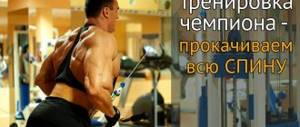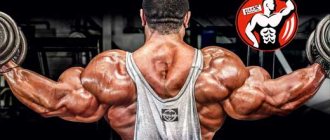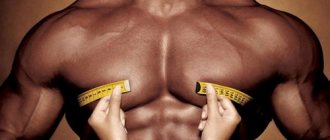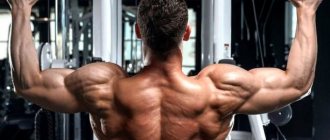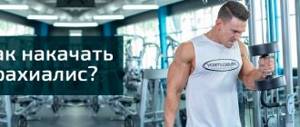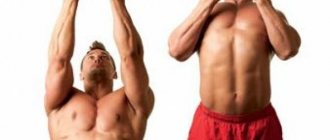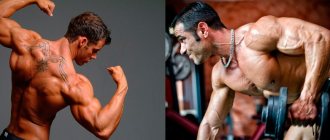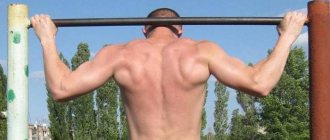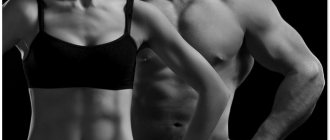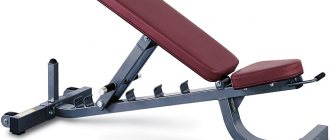Pull-ups on the bar are an exercise familiar to absolutely all boys who were not exempt from physical education lessons at school. Many people have a stereotype from childhood that pull-ups are some kind of standard that needs to be passed for evaluation, and in fact, why else is it needed?! Columnist for the Moscow 24 portal, fitness expert and TV presenter Eduard Kanevsky told and showed how to do pull-ups correctly and why they are really needed.
Photo: Moscow 24 portal/Nikita Simonov
Pull-ups are a basic exercise for developing back muscles. The movement of the arms towards the body and the reduction of the shoulder blades is performed by back muscles such as the latissimus, trapezius and rhomboids. Since we weigh on our arms, the muscles of the arms, in particular the biceps, are also involved in the work. Therefore, those who have weak arms often complain that they are the ones who get very tired from doing pull-ups, and they don’t feel their back at all during the exercise. But the secret here lies not only in weak hands, but in the correct technique for performing the pull-up itself, especially since there are several variations of this exercise that allow you to work out your back muscles as efficiently as possible without going to the gym. A horizontal bar or crossbar is a universal apparatus.
The most basic mistake with any type of pull-up is hunching your back at the top. This is, let’s say, a school reflex, because the teacher made it mandatory to reach the crossbar with your chin. To achieve this result, many rounded their backs, because this way it is much easier to fulfill the teacher’s instructions. Therefore, since we are talking about the fact that pulling up is not just a standard, but an exercise that perfectly develops the back muscles, your task is to pull yourself up not as high as possible, but so that you strongly squeeze your shoulder blades.
Training program for pumping your back on the horizontal bar
Is it possible to pump up chest muscles on the horizontal bar? If you are a beginner, be sure to include horizontal bar exercises in your basic training program. Exercises on the horizontal bar create an ideal load for all muscle groups. To pump up your pectoral muscles with exercises on the horizontal bar, you need your desire, perseverance and regular training.
Please note that if you are interested in losing weight, then you need, on the contrary, to reduce calories and try to train as actively as possible. The simplest and most accessible type of exercise machine is the horizontal bar.
But we note that pull-ups are not the best option for pumping up the chest, since during this exercise they are one of the last to be used.
Load control is an important point in performing pull-ups on the horizontal bar!
The right choice is high-quality exercises, even if in smaller quantities. Over time, the muscles adapt to the loads on the horizontal bar and will require additional stress.
It will be enough to start with three sets of 15 pull-ups on the horizontal bar.
Considering that the horizontal bar is not the best option for pumping up the chest muscles, you can use the crossbar or parallel bars as auxiliary exercise equipment.
Push-up bars have a positive effect on strengthening the pectoral muscle. The load on the chest will depend on the position on the uneven bars. Such simple exercises on the uneven bars will help you quickly pump up your chest, provided you have the correct pull-up technique.
Push-ups on uneven bars or a horizontal bar in combination with the above exercises will be an excellent scheme for achieving results! The fact is that this equipment is multifunctional; it can be used to train different muscle groups, and completely free of charge.
You need to start shaping your figure with the back muscles. If you have an idea of how to pump up muscles more effectively, then you can very quickly and without health consequences acquire sculpted shapes. The main thing when performing exercises is not to overestimate your abilities and not to immediately try to perform exercises that are only accessible to experienced specialists - beginners can easily strain their back or dislocate their arm.
The most important exercise for loading is the classic pull-up. There is no need to reinvent the wheel here. You need to do pull-ups, following the classic scheme, which involves several approaches without various jerks, smoothly. At the same time, it is necessary to monitor the speed of raising and lowering the body - the lower the speed, the stronger the muscles work. Remember that breathing should coincide with the lifting and lowering movements.
- If you don’t know how to pump up your back on the horizontal bar, this is not a problem, do the next exercise correctly. The grip of the hands should be straight, arms parallel to the position of the shoulders. The greatest effect can be achieved if your legs are crossed, your back is slightly arched, and when you reach maximum height during the pull-up, your shoulder blades are squeezed together.
There is a fairly simple, but quite effective exercise for pumping up the trapezius muscles. To perform it, you just need to spread your arms slightly wider than your shoulders; you don’t need to achieve the maximum. As you pull yourself up, try to relax your arm muscles, and don’t forget to squeeze your shoulder blades together.
By regularly and intensely performing wide-grip pull-ups to the chest, the athlete uses almost all of the back muscles and can therefore benefit from the exercise in the following ways:
- the shoulder girdle will visually appear wider;
- the figure becomes more prominent, acquiring the cherished shape of a “triangle”;
- posture improves;
- a moderate tensile load is created on the thoracic spine and all the muscles of the core.
In addition to this, wide-grip pull-ups are an excellent prevention of the following diseases: scoliosis, lordosis, kyphosis, ischemia of the intervertebral discs.
By varying the grip and placement of your hands on the horizontal bar, you can emphasize the load on certain areas of your back. Let's figure out what each type of wide-grip pull-up on the horizontal bar provides.
The most accessible and effective exercise for this muscle group is considered a standard pull-up, as well as pull-ups with the back of the head behind the bar. During the exercise, you must ensure that your elbows are spread in opposite directions at the same angle.
- to do this, the arms are spread to the maximum possible distance, and then the athlete begins to pull himself up smoothly (necessarily smoothly, without jerking - it’s better to pull himself up fewer times, but as expected);
- in addition, the head is placed behind the bar, and pull-ups are performed with a wide grip;
- additional exercise: arms are spread shoulder-width apart, the back is arched, and the legs are crossed. This is the position in which pull-ups are performed.
Pull-ups are the best exercise for adding width to your back. With the right technique, you can significantly increase this muscle group. Below I will tell you how to start “wings” while practicing on the bar.
For those unfamiliar, the “wings” are large, flat, triangular muscles located on the back of the torso, on the sides of the spine from the shoulders to the lower back.
The best results come from wide-grip pull-ups.
The goal of the program: to pump up a wide back.
You can perform this exercise in 2 ways:
- Chest Pull-Ups
With this embodiment, the grip is as wide as possible; you need to reach for the bar with your chest, so you can increase the width and thickness of your back. Throughout the entire approach, each repetition should be smooth and without jerking. It's quality that matters here, not quantity.
- Head pull-ups
This version of the exercise is also done with a wide grip, but is more designed to work on the width of the back muscles, but is not suitable for everyone. When pulling up, you need to put your head behind the bar and touch it with your shoulders. If you have poor shoulder mobility, it is best not to use this option.
Pull-ups have no equal in effectiveness and versatility among other exercises for the back muscles.
Pull-ups pump up your back like no other exercise, but a few sets won't build up an impressive wing. Below you will find a truly effective workout plan for pumping up your back.
Each muscle group has its own standard exercise, performing which this group swings faster. Any training program includes such standard exercises for different muscle groups. When it comes to back training, pull-ups have no equal in terms of effectiveness and versatility.
Raising your body from a hanging position sounds simple, but is not practical for most people. Many basic exercises, such as squats or various forms of push-ups, for example, are found quite often in everyday life, which cannot be said about pull-ups. Even the most pumped-up weightlifters would rather lie under the barbell than climb onto the horizontal bar, because the latter is incredibly difficult to do. Don't be scared right away if you don't succeed the first time. In any case, you have to start somewhere.
To pump up your back and avoid back problems, which are common lately, start doing pull-ups on the horizontal bar right now for preventive purposes and to strengthen your back. This exercise can easily be included in any training plan.
This training plan is aimed at working the back muscles from all sides. The training will take approximately an hour. It includes pull-ups with a variety of grip variations and hand positions. Personally, I always aim to perform about 200 repetitions with minimal rest breaks. I usually rest for about 30-60 seconds.
For beginners, I recommend starting with a pull-up machine, rubber bands to help, or just placing a bench under your feet. There is nothing to be ashamed of - everyone has their own start.
And yet, how to pump up your back on the horizontal bar? Here's my personal training regimen.
| Exercises | How to do |
4-5 sets of 25, 17, 15, 12, 12 reps | |
4-5 sets of 25, 17, 15, 12, 12 reps | |
4-5 sets of 25, 17, 15, 12, 12 reps | |
4-5 sets of 25, 17, 15, 12, 12 reps |
Table of training on the horizontal bar in the form of a picture for downloading
In the empty spaces below, you record the number of reps performed per set and the additional weight, if any. If you performed 10 repetitions with a weight of 45 kg, then write it down as “4 X 10”.
Contraindications for pull-ups
There are several reasons why doctors do not recommend doing pull-ups. You should not exercise on the horizontal bar with the following diseases:
- scoliosis (curvature of the spine);
- spinal protrusion;
- herniated intervertebral discs.
People with osteochondrosis should exercise with caution on the bar. Such exercises will help improve blood circulation and develop mobility of vertebral structures. But excessive load with degenerative changes in the vertebrae is contraindicated. If you have any other back problems, it is recommended to exercise with caution, and do not forget to consult a doctor.
The athlete independently determines which method to choose for learning pull-ups. In such cases, individual preferences are taken into account; whichever method turns out to be easier and more accessible, use it. You can also experiment: do one workout one way, and the next another.
You should practice wisely, follow the technique, do not overload yourself, and then everything will work out.
What muscle groups work when doing pull-ups on a horizontal bar?
It would seem that only the arms do all the work, but the main force is accumulated in the back.
What muscles are pumped on the horizontal bar? The latissimus and trapezius muscles of the back, which are responsible for the work of the shoulders, receive the greatest load. Trapezoids are located in the middle of the upper back and have a trapezoidal shape.
The latissimus dorsi and trapezius dorsi muscles are connected to the biceps, deltoids, pectoralis major and minor muscles. In terms of surface area, the latissimus is the largest muscle in the human body.
The trapezius muscles are also of impressive size, hence the answer to the question: Pull-ups work most of a person’s muscle mass. These muscles are a powerful bundle of energy, so it is worth developing their strength to improve the health of your back and pump it up, making it thicker and wider.
So, first, let’s traditionally look at which muscles work when doing wide-grip pull-ups. The main part of the load when performing the exercise falls on the latissimus, rhomboid, trapezius and teres major muscles of the back, as well as the rear deltoids, biceps and forearms.
The stabilizers in this movement are the spinal extensors, abdominal muscles and serratus anterior muscles.
It is not without reason that the exercise is performed in several variations, since this makes it possible to comprehensively work out different muscle fibers and to influence the muscles and ligaments in different ways with the grip. Only complete and comprehensive muscle development will allow you to increase strength, mass and other athletic performance.
Pull-ups develop:
- latissimus dorsi muscles;
- teres major and minor muscles;
- diamond-shaped;
- trapezoidal;
- shoulder biceps;
- shoulder;
- brachioradialis muscle;
- less often - deltoids and pectoralis.
What muscles determine the appearance of the back?
The relief of the back is provided by the following muscles:
- trapezoidal;
- lats;
- diamond-shaped;
- lumbar (rectifiers).
Almost the entire shoulder girdle, back and small muscle groups are involved in pull-ups. The exercise is considered one of the most difficult and is difficult for girls. But simple movements have many advantages over other back exercises and are worth learning how to do them correctly.
Swinging biceps on the horizontal bar: correct pull-ups
You can achieve an increase in muscle mass with proper nutrition (the right amount of protein) and regular muscle training with muscle load. Constant training allows the muscles to get used to the loads with their gradual increase. Provoke stress for the muscles with the help of additional weights and the result will not take long to arrive!
Let's talk about how to quickly pump up your chest by increasing the working weight from time to time. But first, a few words about the role of proper nutrition for a person interested in increasing muscle mass.
Protein is the main ingredient that helps you gain weight. On average, a person should consume at least two grams of protein per 1 kg of weight.
You should also increase the number of calories you will need per day by 1/3 more than before.
Please note that if you are interested in losing weight, then you need, on the contrary, to reduce calories and try to train as actively as possible. A balanced diet and adherence to a training regimen will help you achieve your desired goal faster.
The following exercises will be your basic exercises for the next month of training.
Many people want to know how to pump up their biceps. Most people have not heard of other exercises on the horizontal bar besides classic pull-ups that are effective for the back muscles. With these exercises you will also learn how to pump up your biceps on the horizontal bar without spending a lot of energy.
If you do pull-ups using a reverse grip, then it is the biceps that will be pumped up. In this case, your hands should be placed next to each other - so that the edges of the palms are already in contact. After hanging, you need to stretch out, arch your back and begin simple pull-ups. The main thing you need to pay attention to is to squeeze your shoulder blades together and pull yourself up as high as possible, trying to reach your arms with your chest.
Another exercise for developing biceps is short pull-ups using a reverse grip, when your arms are parallel to your shoulders. Everything is done the same way, but to perform this exercise correctly, having reached the maximum point of lifting, bend your arms at the elbow at a right angle, then exhale and return back.
- Of course, the chest muscles receive a certain load during any exercise. But still, there is a certain exercise that coaches consider the most effective.
Pull-ups with your arms fully extended and not too wide apart allow you to quickly pump them up. Reaching the top point, lift your chin above the bar. This is difficult to do at first, but the back and chest receive increased stress. Also, when performing these actions, it is optimal to use a mixed grip of the crossbar, when one palm is turned towards you, the other, on the contrary, away from you. Hands are swapped with each approach. But in order for the muscles to develop evenly, there must be an even number of approaches.
When thinking about how to pump up your chest and chest muscles on the horizontal bar, you should calculate the number of approaches. The main thing is to do more than 2 approaches. How much you can do depends on your physical fitness.
So, if there is a horizontal bar freely available, then it is quite possible to build strong and defined muscles without going to the gym. The main thing is patience and perseverance.
- start doing pull-ups with a reverse grip, i.e. with hands placed on the bar with palms facing you and at a narrow distance;
- hang on the horizontal bar, placing one palm on the other. Bend your back and pull yourself up in this position. When performing the task, you should move your shoulders back and bring your shoulder blades together;
- grab the bar of the apparatus with a reverse grip and shoulder-width apart (this is related to the question of how to quickly pump up on the horizontal bar). Inhale and pull yourself up to chest level, then exhale and touch the bar with your chest, then return to the starting position.
With different types of pull-ups, different muscles are loaded, however, in general, the exercise most develops the chest, back, arms and shoulders. Let’s look separately at which muscle group is worked by each type of pull-up.
Under any load, in any exercise, exhalation is always performed with effort. Thus, from the beginning and to the peak of contraction, you need to exhale, and in the negative phase (relaxation) - inhale. Therefore, when pulling yourself up to the bar, you exhale powerfully, and when you straighten your elbows, you inhale smoothly.
If an athlete is still just mastering pull-ups with his own weight, even from scratch, it is important to always test the load “until the muscles fail”; on the last repetitions, it is necessary to pull up with all your might until the muscles refuse to work. What matters is what goals the athlete pursues.
- If an athlete is training power and strength, it is necessary to perform 3-6 repetitions per set, you can work with additional weight.
- If the goal is to increase muscle volume, then 8-12 repetitions should be performed.
- And if you need to increase endurance, speed, and simply work on quantity, perform 15 repetitions or more.
For training to be beneficial, train your back no more than 1-2 times a week. The large back muscles take 5-6 days to recover, so do not rush to do pull-ups until the muscles have fully recovered. The optimal number would be 3-4 approaches.
If you find it difficult to do even a few wide-grip pull-ups, then the table below may be useful to you. This wide-grip pull-up program is designed for 5 weeks, training is carried out 3 times a week, much attention is paid to lead-up exercises and periodization of the load. With this program, you can quickly increase the number of pull-ups up to 15 times in one approach.
| A week | Workout number | Workout plan |
| First | 1 |
|
| 2 |
| |
| 3 |
| |
| Second | 1 |
|
| 2 |
| |
| 3 |
| |
| Third | 1 |
|
| 2 |
| |
| 3 |
| |
| Fourth | 1 |
|
| 2 |
| |
| 3 |
| |
| Fifth | 1 |
|
| 2 |
| |
| 3 |
|
When doing pull-ups, use a narrow grip; it helps to thoroughly work the chest muscles. To increase the load, try tilting your upper body back while lifting, and simultaneously moving your legs forward. Perform 3-5 sets of 10-15 reps.
There is another interesting exercise:
- starting position – hanging;
- Reach your left shoulder with your right knee, then reach your right shoulder with your left.
If you don’t have enough strength, you can only touch the chest, but the effectiveness of the exercise in this case will be noticeably lower.
Pumping up the abdominal press allows the athlete to increase strength in other basic exercises. Exercises for the oblique abdominal muscles are performed not only by bodybuilders and powerlifters. Often this zone is also pumped up by track and field athletes (throwers of sports equipment), snowboarders, figure skaters, gymnasts, boxers, representatives of some team sports, and, of course, crossfitters.
However, do not forget that excessively pumped oblique muscles visually make the waist wider. If you do not want this effect, you should not put too much emphasis on this muscle group. 1-2 exercises per week is enough.
How to pump up your oblique abdominal muscles in the gym? There are two main options - pump up your abs once a week (4-6 exercises) or at the end of each workout (3 times a week, 2-3 exercises). In the first option, 3-4 exercises will be on the rectus abdominis muscle and 1-2 on the obliques. In the second - 1-2 on a straight line and 1 on obliques.
| Exercise name | Abdominal muscles involved | Number of approaches and repetitions | Photo |
| Incline crunches | Straight | 3x12-15 | |
| Hanging Leg Raises | Straight | 3x10-15 | |
| Crunches in the simulator | Straight | 3x12-15 | |
| Lateral crunches on a crossover | Oblique | 3x12-15 | |
| Tilts on the lower block | Oblique | 3x12-15 |
| Exercise name | Abdominal muscles involved | Number of approaches and repetitions | Photo |
| Incline crunches | Straight | 3x12-15 | |
| Hanging Leg Raises | Straight | 3x10-15 | |
| "Lumberjack" on the block | Oblique | 4x12-15 |
How to pump up your oblique abdominal muscles at home? Very simple! The oblique muscle exercises we suggest below can be performed in almost any environment. In order to pump up your abs well, you don’t always need to buy an expensive subscription to a fitness center. The main thing is to have patience and strive for your goal.
At home, the principles of building a program are no different from training in the gym. Only the exercises change.
Training biceps on the horizontal bar requires following some rules. First, you need to make the right grip. Once you learn how to do this, consider yourself halfway done. To prevent the exercises you perform from turning into torture, buy yourself a pair of gloves. Otherwise, your exercise will cause blisters on your palms, which will soon burst and become very painful.
To pump up your biceps on the horizontal bar, all pull-ups must be done with a narrow reverse grip. In other words, before you grab the bar with your hands, turn your palms up, that is, grab it from below. In this case, it does not matter at all what the distance is between your hands. If you perform exercises with a reverse grip, they will give a positive result one way or another.
We pump up our shoulders on the horizontal bar
Worried that you don't know how to pump up your shoulders on the horizontal bar? It’s not worth it - such exercises already exist. The shoulder muscles receive stress during all exercises on the bar. But you can load them as much as possible if you perform deep pull-ups, while keeping your arms straight.
There is a very effective exercise called “strength release”. It requires very good physical preparation due to its complexity, so it is not intended for beginners. During it, you need to raise your body above the bar so that your hands are below. Such regular exercises will give a big increase in shoulder muscles.
The horizontal bar can be safely called a universal equipment. With its help, at home, men can not only pump up their shoulders, but also change their entire figure.
Shoulder training on the horizontal bar at home includes the deltoid and trapezius muscles. Wide shoulders will protect the athlete from injuries to the spine and cervical spine. Men will gain correct posture and visually enlarge their upper torso.
Why do you need to pull yourself up?
The back muscles are large and grow quickly when stimulated. Just look at the photos of modern bodybuilders whose latissimus muscles look like wings. But popular training programs for them mainly consist of exercises that are unsafe for the spine. Pull-ups are a quick and harmless way to develop your back.
During the exercise, the spine is stretched, the hands and joints are strengthened, and the hips and abs receive static load. A strong back helps you get a powerful chest, broad shoulders and correct posture.
Pull-ups help:
- improve back relief;
- develop the muscles of the shoulder girdle and upper back;
- strengthen grip strength;
- increase the working weight in other back exercises;
- increase the production of growth hormone, which affects muscle growth and fat metabolism.
Pull-ups are useful for athletes who have an overdeveloped anterior deltoid - they strengthen the posterior deltoid muscle, thereby getting rid of imbalance.
Grip options
Reverse grip pull-up
Most often, a direct grip is used for pull-ups, but a reverse grip (when the athlete grabs the horizontal bar from below with his hands) is also quite acceptable. Combined grip - when one hand is placed in a reverse grip, the other in a straight grip. With a combined grip, the torso is located at the crossbar.
“Angle” pull-ups, that is, pull-ups with legs straightened and positioned at chest level, help train the abs and pectoral muscles. If difficulties arise with this exercise, it means that the person’s abdominal muscles are poorly developed and need to be strengthened.
For those who have learned to do more than 15 pull-ups, you can try working with weights - additional weight. After all, by pulling up only with your own weight, a person “freezes” progress at some level. For weights, you can use a special belt or put a backpack with something heavy on your back (for example, 5-6 thick books). Some athletes ask someone to hang on to them during pull-ups.
One-arm pull-ups are one of the most difficult types of exercises used by people. Such a pull-up can be performed only after the athlete has learned to do pull-ups in the usual way more than 20 times. The exercise is dangerous for the ligaments, so you need to be as careful as possible.
You need to start mastering the technique of one-arm pull-ups from the moment that when doing pull-ups, the second hand must hold onto the wrist of the working hand. As you train, the second hand is moved to the forearm, to the biceps, and finally to the shoulder. For one-arm pull-ups, 3-4 repetitions are enough. Sudden movements when performing the exercise should be avoided, and you should listen sensitively to pain sensations.
Considering that pull-ups can be performed in various ways, the question arises about the difference in muscle activity during the execution of one or another method. We compared the exercise with a regular (direct) grip, a reverse grip, and a “perfect” grip (which is a pull-up on two handles capable of rotating 360°).
The following points were identified experimentally:
- when comparing exercises performed with a direct and reverse grip, we found a greater load on the lower portion of the trapezius muscle in the first case;
- when we compared exercises done with a straight grip with “perfect” ones, in the first case greater activity was observed in the infraspinatus muscle;
- a comparison of the “perfect” pull-up and that performed with a reverse grip showed that greater activity of the latissimus dorsi muscles was in the first embodiment;
- a reverse grip puts an increased load on the pectoral muscles and biceps brachii muscles compared to a straight grip.
As for the effect of wide and narrow grips when performing pull-ups on muscle activity, various experiments did not reveal any significant differences. No changes were found in the mid-trapezius, biceps brachii, or latissimus dorsi muscles when performing pull-ups with different grips.
It's mostly up to you to decide how to grip the bar with your hands. Purely intuitively, people choose the straight grip that is most comfortable for them. It is worth changing the types of grip from time to time, which will allow the same muscles to work differently.
A narrower reverse grip, with the palms facing toward the shoulders, is used to work the arm muscles, especially the biceps. To pump up the latissimus dorsi muscles, use a wider, straight grip with your palms facing outward, this will allow you to pump up your broad back as quickly as possible. You can change and alternate grip types right during training, which is very useful so as not to overload only one muscle group.
Watch the video for better clarity. Here are collected different types of pull-ups and demonstrated the technique for performing each. Any option can be safely added to the training plan proposed above. I hope the information I collected will help you eventually learn how to pump up your back muscles on the horizontal bar.
By width.
- Narrow grip - palms placed close to each other on the bar.
- Medium grip – palms are positioned the width of the shoulder joints.
- Wide grip - palms are located wider than the shoulder joints, closer to the edges of the bar.
According to the location of the brushes.
- Parallel (neutral) - a narrow or medium grip, in which the palms are located parallel to each other on special handles or crossbars.
- Direct grip - palms clasp the bars from above, with the back of the hand facing the athlete.
- Reverse grip - palms clasp the bar with an underhand grip, with the back side facing away from you.
- Different grip - one hand clasps the bar with a direct grip, and the other with a reverse grip.
How to do pull-ups correctly?
To master good technique, you need to keep your entire upper body tense, without pulling your shoulders towards your ears or throwing your head back. In the starting position, you need to take a deep breath and, straining the latissimus dorsi muscles, stretch upward. As you exhale, you can slowly lower yourself down. You need to pull yourself up using force, and not swaying by inertia. The swings that amateurs use only loosen the joints. Only professionals who proudly demonstrate the perfect technique in video lessons can apply them correctly.
In the lower position, you cannot relax completely and straighten your arms completely - your elbows should remain slightly bent. This will remove excess stress from the elbow joints and make it easier to lift up. Tension in the shoulders will help you avoid unnatural bends and dislocation of the shoulder joint.
At first, you can use the most comfortable grip. As you master the technique, change the position of your hands. Gymnastic rings are ideal for doing pull-ups, allowing your hands to move naturally. The position of the legs does not play a big role in the distribution of the load: the legs can be kept straight or bent and crossed under the body.
How to pump up ripped abs
To pump up a sculpted press, you need to pay attention to the two most important exercises, intended for the upper and lower parts of it. Here the starting position is a completely hanging relaxed body. Next, you need to tuck your knees and pull your legs closer to your chest, and if possible higher. You need to stay in the top position for a few seconds. The next stage is to raise your legs without bending your knees.
The upper part of the abs is trained by hanging upside down on a horizontal bar. From this position, you need to pull the body as close to the knees as possible, touch them and fix this position of the body for a few seconds at the reached point. If you compare it with the exercises that are required to pump up your arms and back on the horizontal bar, you will notice that pull-ups are not required here.
— hang on the machine and raise the lower limbs at a right angle;
- also hang on the machine, but with your knees bent. Make circular movements with your body left and right;
- again, hang on the apparatus and raise your legs up to your chin, holding the position for as long as possible.
Pull-ups for the back in video format
And also read how to learn to do pull-ups many times →
Source
≡ February 12, 2021 Category: Exercises by muscle group
Beginners strive to pump up their torso, arms, shoulders and legs, paying little attention to their back and undeservedly ignoring pull-ups. Inexperienced athletes consider the basic exercise ineffective and even dangerous. Contrary to prejudices and myths, back exercises on the horizontal bar and parallel bars develop muscles and are not harmful to health. If it is easy to injure the lower back when lifting the barbell incorrectly, then the body in the air retains its natural curve and the back does not receive external load. Don’t know how to pump up a V-shaped back on the horizontal bar? Use the recommended complex and combine pull-ups with other exercises.
